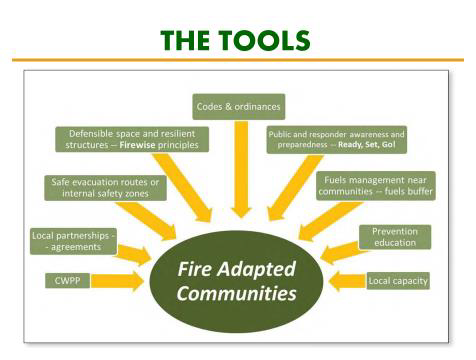- About Us
- Events & Training
- Professional Development
- Sponsorship
- Get Involved
- Resources
Community Resilience: FireWith all the precipitation we have had this winter and spring, Washington communities can expect lush vegetation growth in spring and early summer, leading to lots of dry materials to fuel wildfires later in the season. So how do communities, particularly those near forest land, prepare for and recover from this repeating cycle? There are many ways to go about it, but several national programs and codes have been developed to help communities reduce the risks, respond effectively and recover more quickly from fires. Teaching people how to live with the natural threat of wildfire The National Fire Protection Association (NFPA) has developed the Firewise Communities program to help neighborhoods, towns and cities to reduce the risk to residents and buildings, and to respond quickly and effectively to fires that occur. The program encourages local solutions for safety by involving homeowners in taking individual responsibility for preparing their homes for the risk of wildfire. Firewise is a component of Fire Adapted Communities - a collaborative approach that connects all those who play a role in wildfire education, planning and action with resources to help reduce risk. The program is co-sponsored by the USDA Forest Service, the US Department of Interior and the National Association of State Forests. Resources are available to help communities with risk assessments, prioritizing actions to reduce risk and respond effectively and educate the community on the issues and actions they can take. Information and resources are provided at the links in the above paragraph. To save lives and property from wildfire, NFPA’s Firewise Communities program teaches people how to adapt to living with wildfire and encourages neighbors to work together and take action now to prevent losses. We all have a role to play in protecting ourselves and our neighborhood from the risk of wildfire. What makes a community “firewise”? Communities that are “firewise” have identified the risks they face and taken appropriate steps to become more resistant to wildfire structural damage. Actions include:
In addition, communities that have followed a systematic approach to planning for and mitigating fire risk are certified as Firewise Communities. This recognition involves on-going actions to educate the public and taking steps to reduce risk and improve responses and resilience. Over 1,400 communities nationwide participate in the program.
A local example Yakima County began discussing the need for fire prevention education and regulation in 1999 as development extended into wildland-urban interface areas. Informal meetings were held by representatives from a number of fire protection districts. Citizens lead the charge to explain the hazards of living in wildfire-prone areas. In concert with these efforts, the Yakima County Planning Department was reviewing requirements for development in natural resource areas. As the 2000 wildfire season progressed into one of the most disastrous in Washington State history (at that time), public awareness of the fire problem increased. Locally this was vividly illustrated when a wildland fire threatened the Hanford Nuclear Reservation and spread from Benton County to Yakima County. The County Commissioners directed the Fire Marshall’s office to begin developing measures to reduce risk and protect residents. In 2000, after several months of stakeholder meetings that included a risk assessment and mapping of the County to identify various risk zones, the stakeholders recommended adoption of the International Codes Council’s Wildland Urban Interface Code (WAC 51-54A-8100, Appendix K). Enforcement of the provisions of this code became the responsibility of the Fire Marshal’s Office. Staff was further directed to develop and deliver public safety education programs for wildfire prevention to meet the needs of various interest groups within the community. This article is a result of the Ten Big Ideas Initiative, an outgrowth of the Game Changing Initiative designed to bring about far-reaching and fundamental change on a variety of issues. Topics include addressing climate change, rebuilding our infrastructure, restoring and protecting our ecosystems, supporting economic development and supporting sustainable agriculture. For more information on the initiative and Yakima County’s work, please see the WAPA website.
|


